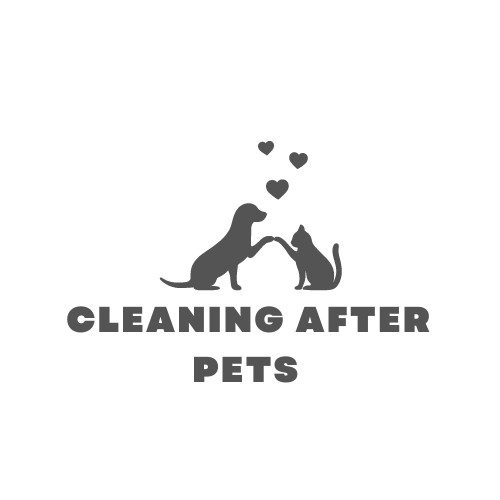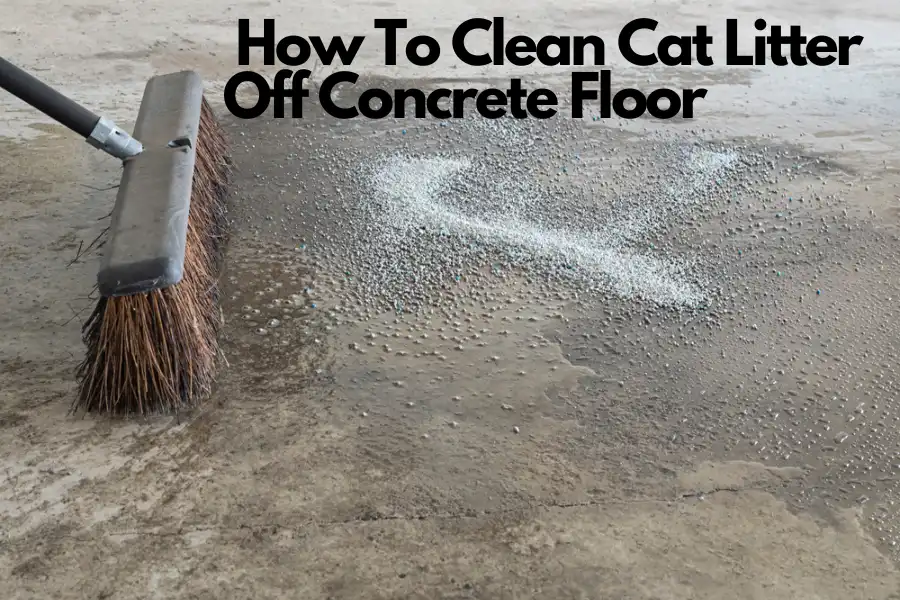If you have a pet cat, you must appreciate that they can be messy, such as when they do not use their litter box to do their business. For example, your cat can track or kick litter out of its litter box, which can quickly get stuck on concrete floors and cause unsightly stains if not cleaned up promptly.
Unfortunately, getting cat litter stains from concrete is not always easy, especially when the stain has dried on the surface.
That being said, you should not worry! This article will show you the best ways to clean wet cat litter off concrete floors and eliminate persistent litter stains.
There are a few rules regarding how to clean cat litter off concrete surfaces. One rule you must follow religiously is to clean as soon as you notice the mess. You can start with simple cleaning processes like sweeping, collecting the litter on a dustpan, and disposing of it in a trash bag or cat litter waste bag.
Allowing the cat litter to sit on the floor for a long time makes removing it more difficult. Therefore, wear your protective gloves and get right to work. This step helps to remove most of the litter stains from your floor before applying the cleaning agent.
However, if the litter falls or dries on your concrete floor, you must use more in-depth cleaning methods to clear the stain and neutralize the cat urine odor.
Precautions to Take When Choosing Cleaning and Hygiene Products for Cat Parents
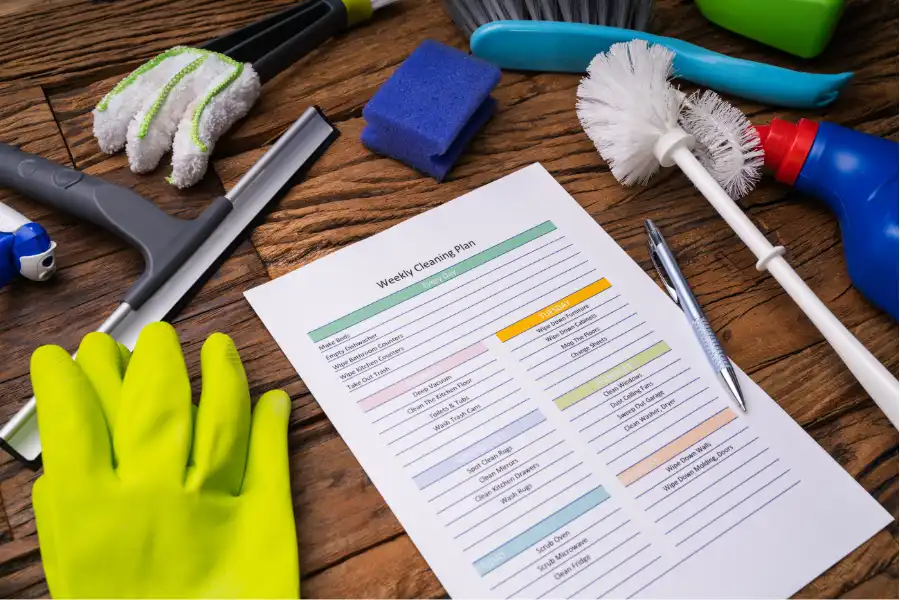
When selecting cleaning and hygiene products, the major concerns for most pet parents are centered on their cats’ health and safety and protecting the floor surface from damage caused by harsh cleaning chemicals or bleaches. Below are examples of precautions to remember:
1. Read Labels And Follow The Instructions For Use
Only use cleaning products safe for your cats. Before buying or using any store-purchased cleaning product, read the product’s label carefully to determine if they contain ingredients toxic to your cats or can be used to clean your flooring without discoloring or etching it.
Importantly, follow the usage instructions to increase the chances of success, safeguard the floor from damage and prolong its life.
2. Look For Products Formulated For Pets Poop And Urine
Choose a hygiene product specifically formulated for removing cat litter from concrete floors when looking for the right cleaning products for cat-specific stains.
Pet-specific products will get the job done while protecting your cat’s well-being. Crucially, most pet-safe cleaners, such as enzymatic cleaners, do not react with concrete and will not cause severe damage to the floor.
3. Invest In Safe And Ecological Products Only
Opt for pH-neutral cleaning solutions, which will not damage your floor, irritate your skin, and are safe for the environment. They are also relatively easily rinsed from the floor surface, thus preserving water. Other cleaners, like the OdoBan Neutral pH Floor Cleaner, are designed for no rinsing.
You should note there are consequences of using unsafe cleaners for cat mess. It is common for cats to experience vomiting, seizures, stomach upsets and diarrhea, chemical burns, respiratory infections, kidney failure, and liver failure when they ingest, inhale, or come into contact with the harsh cleaning chemical or even their residue.
Since you’re most likely cleaning the floor close to where you’ve placed the litter box, you should only use pet-safe cleaning solutions.
Besides your cat’s health, you must safeguard the rest of the flora and fauna in your surroundings, including yourself. Look for non-toxic and eco-friendly tags when buying cleaning and hygiene products.
4. Avoid Products With Harsh Chemicals
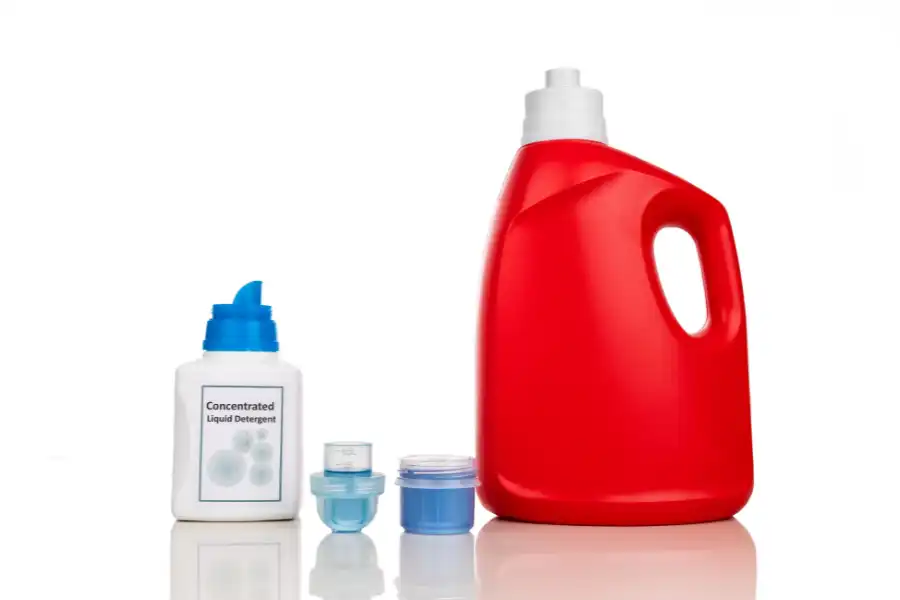
While you might try to clean with common household cleaning solutions, you should be wary of using harsh chemicals.
Most cleaning products containing harsh chemical ingredients like Alkyl dimethyl benzyl ammonium chloride (BACS) – commonly used in household disinfectants, bleach, ammonia, Isopropyl Alcohol, and compounds with phenols can be toxic to your cat, particularly when ingested or inhaled.
Moreover, you have to consider the state of your concrete floor. It is best to avoid using bleach, ammonia, vinegar, or cleaners like Pine-sol when dealing with polished or stained concrete floors. These cleaners may discolor or etch the flooring surface, damaging its appearance.
5. Prioritize the Use Of Non-Scented Products
With feline olfactory cells being 14 times stronger than humans, most cats are sensitive to strong odors. When cleaning surfaces at home, you should consider whether the scent of the cleaning products will adversely affect your cat.
Typically, scented products can overwhelm your cat and lead to litter box aversion and other unwanted behavioral changes. Buy unscented, scented cleaning products or those that contain natural and moderate scents.
Also, do not use undiluted essential oil to mask the cat pee odor.
6. Store All Products Safely
When not in use, store the cleaning and hygiene products safely and out of reach for your pets and kids.
Learn How To Get Cat Litter Out Of Your Laminate Flooring
Preparing A DIY Cleaning Solution
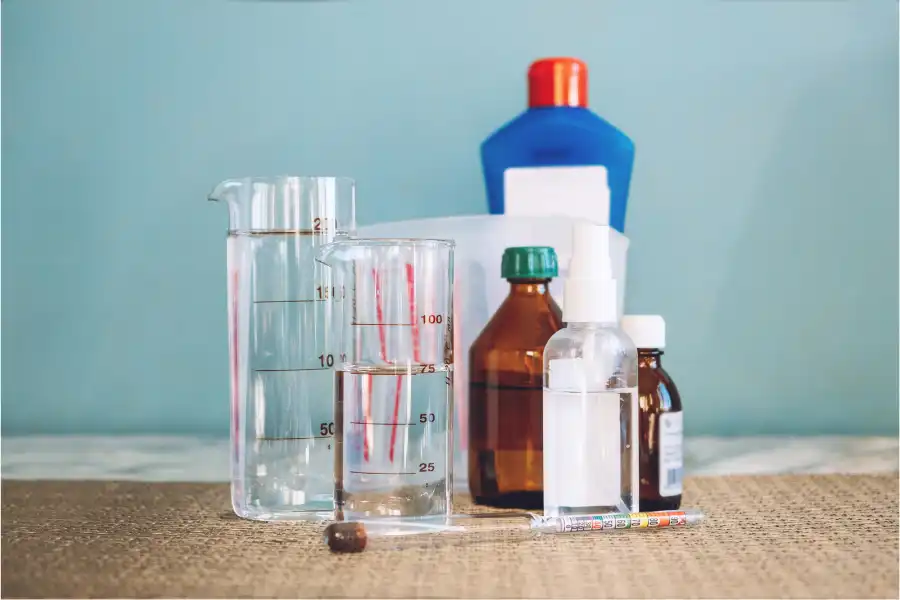
The next step is to prepare an effective cleaning solution. Indeed, selecting the ideal cleaning agent for the task at hand is just as important as the efficacy of the cleaning process itself. Besides working with a store-bought floor cleaner, you can prepare your DIY cleaning agent.
Mix equal parts of water and white vinegar in a spray bottle. Close the bottle and shake for the solution to mix well, and you are done.
White vinegar is widely used as a cleaning agent in many households due to its acetic acid, which is between 4% and 6% by volume, and a natural all-purpose cleaning and deodorizing agent. White vinegar is also affordable and safe around cats and other pets.
If you opt for a commercial cleaning agent, look for one ideally formulated to remove pet stains from the concrete floor, break down the organic matter in cat litter, and eliminate odor like an enzymatic cleaner.
How to Clean Up Dry Cat Litter Spilled on Floor And Heaps Of Loose Litter
In most cases, you will encounter a heap of dry cat litter that you have to eliminate. The soiled cat litter might have dried in place, allowing the litter to stick to the floor. Here is how you can do it, along with the tools and supplies you need:
1. Sweep the litter with a broom and a dustpan, and try to collect as much as possible. Ensure you are wearing protective gloves. Use a sweep hand broom to sweep up litter particles and dust from corners and hard-to-reach areas.
Throw the litter in a double-bagged trash bag or buy cat litter waste bags that come with drawstrings to help keep the dirt securely locked in the bag.
2. Vacuum up the remaining litter with a vacuum cleaner – preferably a handheld vacuum suitable for picking up cat litter instead of your regular vacuum cleaner.
3. Apply your preferred cleaning solution on the stain and allow it to sit for a few minutes to disintegrate and ‘loosen’ it. For this work, you can use the effective DIY cleaning solution or store-bought concrete floor cleaner specially formulated to remove cat litter from concrete floors.
Moreover, consider using pH-neutral cleaning solutions to wash your concrete floors, like OdoBan floor cleaner, which is biodegradable and an effective concrete floor cleaner and deodorizer.
Please note that you may need an enzymatic cleaner or concrete degreaser if the litter stain on your floor contains cat pee or poop that has dried on the concrete surface. Enzymatic cleaners are ideal for removing organic-based stains from concrete and will eliminate any unpleasant odors that may linger after washing the stain.
Step #4: Consider scrubbing the stains with a suitable concrete brush, especially when dealing with hardened and persistent cat litter stains and residue on the floor. If the litter stains have not yet hardened on the floor, you can use microfiber cleaning pads to remove them.
Soak a cloth or microfiber cleaning pads in clean soap water containing some mild dishwashing soap like Dawn Dish Soap, and wring out the excess water from the cloth. Use the damp cloth to scrub and remove the residue litter on the floor.
If the litter is already soiled, you must apply a suitable cleaning agent to kill off any poop or pee odors that could be lingering on your floor. Ideally, look for a concrete floor cleaner formulated to remove organic stains from the floor or apply an enzymatic cleaner or vinegar solution.
5. Rinse off the spot to remove the cleaning solution and any washed-off litter particles. Do this until all the litter is gone.
6. Allow the area to air dry thoroughly, or use a dry and clean towel to get rid of the excess water.
How To Clean Wet Cat Litter Off Concrete Floor
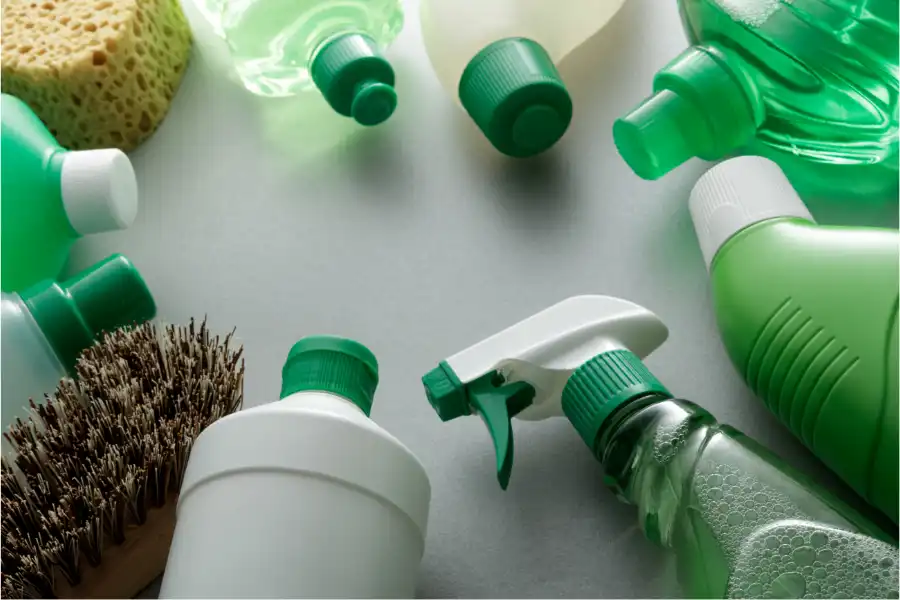
Cleaning wet cat litter from the concrete floor slightly differs from cleaning up dry litter from your concrete floor. Depending on how wet the litter stain is, you should start by blotting the stain to remove the wetness first.
Unlike dry litter particles and dust, pet cat owners should avoid vacuuming wet cat litter with regular vacuum cleaners. This is because, when mixed with water, most cat litter behaves like concrete, which means vacuuming wet litter can be like vacuuming small rocks that can damage your ordinary vacuum cleaner.
Not to mention, cleaning up wet cat litter can cause regular vacuum cleaners to clog easily.
Here is how you can do it:
#1. Use a paper towel, dry towel, or clean cloth to blot the spot to remove as much moisture from the floor as possible. You may have to repeat this step until all water is gone.
#2. Next, use a spatula, scraper, or an old spoon to scoop and lift as much litter debris particles as possible and throw it in a trash bag (preferably double-bagged) or specially designed cat litter waste bags. You can also use a sweep hand broom and a dustpan – do this gently to avoid damaging or scratching the floor.
#3. If any smaller litter debris remains on the floor, you can use a broom to sweep them onto a dustpan or vacuum them up using a handheld vacuum suitable for picking wet cat litter from the floor.
#4. Then, apply an effective cleaning solution to the stain. Our guide above provides instructions on how to create your own DIY cleaning solution if you prefer to do so. You can also opt for a commercial floor cleaner specially formulated to remove pet-specific stains from concrete floors, such as cat litter.
When utilizing commercial cleaning products, it is crucial to carefully read and adhere to the instructions provided, particularly with regard to following the manufacturer’s recommended usage guidelines for the product.
#5. Allow the cleaning product to sit on the stain for a few minutes. Scrub any stubborn litter with a stiff-bristled brush to loosen and detach it from your flooring.
#6. Now, rinse the area with clean water to wash off any residual litter and cleaner. Consider repeating the above steps if the litter remains.
#7. Dry the area with a dry, clean towel or allow it to air dry completely. You can also place a dehumidifier or fan in the room or open any windows to improve ventilation and quicken drying.
You Might Also Be Interested In learning How To Clean Cat Litter Of Wood Floors
Dealing with Hardened and Persistent Cat Litter Stains and Residue

Removing hardened cat litter stains may be challenging as hardened litter tends to adhere to the floor. Furthermore, the persistent cat litter may contain cat urine, leaving a strong odor behind.
You can use baking soda paste or a commercial stain remover to eliminate the stubborn stains and neutralize the foul odor. This is because baking soda is a natural and effective cleaner for various surfaces, including concrete. However, if you use a commercial stain remover, follow the manufacturer’s instructions carefully.
Here is how you can deal with hardened and persistent cat litter stains and residue:
#1. Use a plastic scraper or spatula to gently remove the hardened cat litter without damaging the concrete floor.
#2. Sweep as much litter debris as possible onto a dustpan and discard it into a trash bag or cat litter waste bag. Since the hardened litter debris from the floor is dry, you can vacuum it up with a handheld vacuum cleaner and proceed.
#3. Apply an effective cleaning agent on the stained patch. For instance, you can mix equal parts of water and baking soda to create a paste of an effective DIY cleaning agent.
Alternatively, spray or drench the litter stain with a solution of one part water and one part white vinegar. Also, consider purchasing a suitable floor cleaning product from your local store or online.
#4. Allow the cleaning solution to sit on the litter stain for at least 15 minutes, and scrub the hardened litter with a stiff-bristled brush. Do this carefully to avoid damaging your flooring. If the stain does not come off, consider scrubbing it off with a steam mop or a pressure washer to remove the cat litter stains.
#5. Use a cloth and clean water to rinse and remove any residual cleaning solution and litter on your floor. It might be necessary to repeat these steps depending on how much the litter has hardened on your floor.
#6. Dry the area with a clean towel or allow it to dry. You can bring a dehumidifier or fan into the room to accelerate drying.
Can Clumping Litter be Flushed?
Often, cat owners are not allowed to flush clumping litter down the toilet as it is non-biodegradable. Despite most types of cat litter being labeled as “flushable,” dumping clumping litter in your toilet can lead to clogging of the pipework and subject you to expensive plumbing repairs.
Standard toilet drainage systems are designed only to bear a limited load. In some areas, the municipal sewer systems can handle cat litter, allowing some cat keepers to flush the old litter down the toilet, while in others, it is prohibited.
As such, ensure you find out whether or not flushing cat litter is allowed in your municipality. If you use a private septic system, seek advice from a trusted plumber.
Generally speaking, the risks of flushing clumping litter down the toilet far outweigh the benefits, especially when safer and more effective methods are available.
Learn How to Get Cat Urine Smell Out of Clothes
Learn How To Get Rid Of Cat Poop On Shoes
Suggestions for Disposing of Clumping Cat Litters

With most plumbing experts advising homeowners not to dispose of cat litter by flushing it down the toilet, you need to find a more effective alternative.
More importantly, the disposal methods should be safe. It is not just a matter of how to clean cat litter off concrete as fast as possible. Safety is also a critical consideration.
Cat poop contains parasites such as Toxoplasma gondii, which can harm human health, with pregnant women at greater risk. Disposing dirty cat litter in a toilet exposes human life to such parasites and puts them at risk of developing more health issues.
Below are better ways of disposing of clumping Litter:
Pack It In Cat Litter Disposal Bags And Send It To The Landfill
One of the most preferred ways is disposing of the litter in a double-bagged trash bag, tying or sealing it, and putting it in the trash bin. Ensure the trash bag is tied tightly and put away from kids and pets.
Luckily, cat litter waste bags come with drawstrings to help keep the dirty litter secured in the bag. Consider using them for this work also.
Remember, cat poop contains parasites such as Toxoplasma gondii, which is risky to human health, and for this reason, it is vital for soiled cat litter to be kept away from kids and any form of human contact.
Send It To The Landfill
After bagging the litter, you can dump the cat litter waste in a landfill. If this method is more appealing, remember that non-biodegradable litter takes many years to rot when dumped in a landfill. In contrast, biodegradable litter disintegrates a few months after being disposed of in a compost pile or landfill.
Compositing
Composting is an excellent alternative to packing the litter in a cat litter trash bag and sending it to the landfill. Compositing is especially effective when you use natural litter such as wood chips.
If you choose this option, set aside a compost bin for cat litter only and another for other compostable waste like food leftovers. Also, confirm that your local compositing facility has included cat litter in their composting program.
How to Dissolve Clumping Kitty Litter On A Concrete Floor
As a cat owner, you’d think that dissolving cat pee is much easier and faster than cleaning litter on concrete floors. However, you should not dissolve clumping litter, which can easily lead to numerous plumbing issues and other far-reaching environmental concerns.
As the name suggests, clumping litter usually clumps together when exposed to moisture. This is why flushing the clumping litter down the drains can clog the drainage system in your home. Exposing clumping litter to water will only make the litter solidify to mass rather than dissolving the litter.
Furthermore, exposing the litter risks spreading dangerous parasites such as Toxoplasma gondii, which can be carried and transmitted through cat poop. This is why it is critical that soiled cat litter is disposed of appropriately and not merely dissolved and dumped down the house drains.
As mentioned earlier, other ways of disposing of old cat litter include a landfill or composting.
Also, if you prefer easily disposable cat litter, consider non-clumping litter made from corn, recycled paper, pine, or horse bedding pellets. The bottom line is always to follow the manufacturer’s instructions when packaging old and dirty litter for disposal.
Why is My Cat Tracking Wet Litter Onto My Floor?
Litter sticking to your cat’s fur and paws is one of the main reasons your cat might be tracking wet litter out of the litter box. However, your cat can track litter to the floor due to the following reasons:
Cat’s Litter Is Too Wet
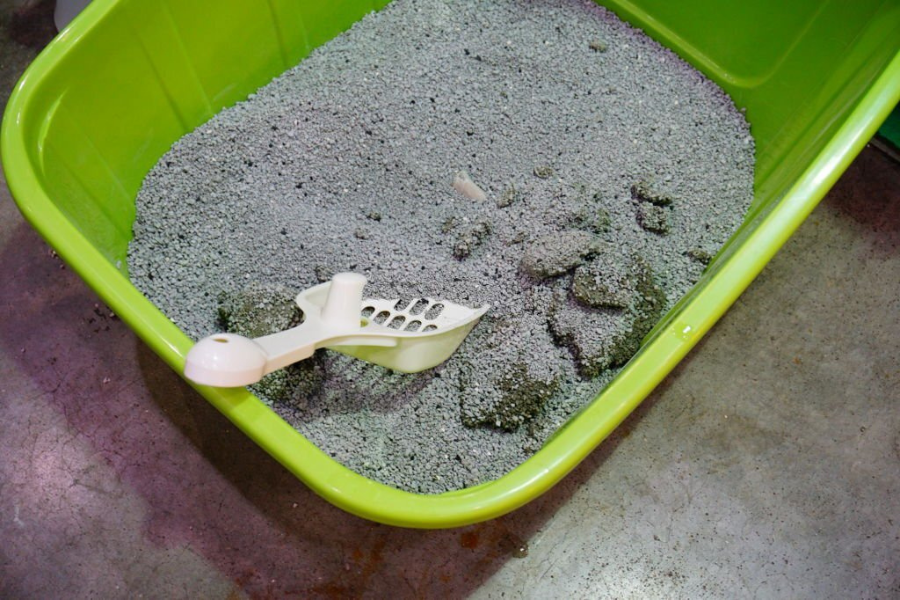
The cat’s litter can become too saturated or clumpy and stick to your cat’s paws, making it easy for your furry friend to track litter to your concrete floor. To avert such a situation, consider scooping and changing the litter more frequently or try a different type of litter that clumps faster.
Your Cat Has Difficulties Using Its Litter Box
Your cat is likely to develop bad litter box habits if it is uncomfortable using the litter box you have provided. Consequently, it might develop bad bathroom habits for such reasons like:
- The litter box is too tiny for your cat to move around and bury its waste properly: The litter can quickly become wet and sticky and be tracked outside the litter box more easily.
- The litter box is dirty: You may need to scoop the litter box more regularly to maintain sufficient dryness and prevent the litter from sticking to the cat’s paws.
- The litter box is placed in a noisy and high-traffic area: This can explain why the cat is always in a rush to use and exit the litter box, often overlooking to cover its waste. Without taking time to bury the litter, it is more likely for the cat to track litter outside the box and find its way to your concrete floor.
Preventing Future Cat Litter Spills and Keeping Cat Litter off the Floor
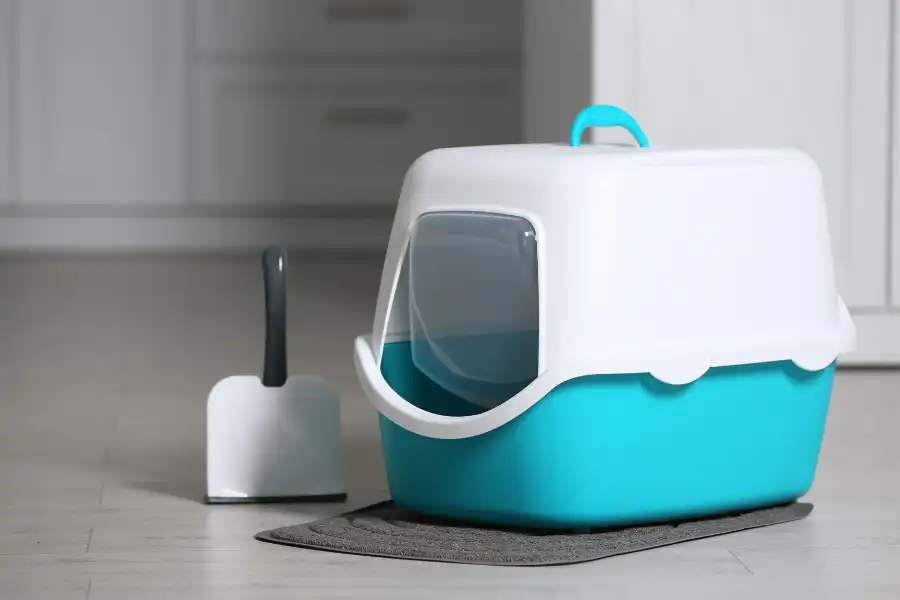
Preventing future cat litter spills is critical to keeping your concrete floors clean and stain-free. Some of the ways you can avoid future cat litter spills include:
- Place the litter box over a floor type that is easy to clean; however, the litter box must be in a low-traffic area with sufficient privacy for your cat.
- Have your concrete floor appropriately sealed to enable its surface to resist stains and abrasion. An effective sealer protects your concrete floor from pet-specific stains like cat litter. Sealers also extend the life of your concrete floors.
- Place an easy-to-wash litter box mat like the Pieviev Cat Litter Mat below the litter box to trap any litter debris kicked out or tracked out of the litter box. Also, a textured mat traps litter to keep it away from your floor. Usually, the litter mat is designed with a raised grid surface or rough hairy surface to help trap and hold the litter particles that fall from the litter box.
- Scooping and cleaning the litter box regularly to prevent overflow is also crucial. Also, consider changing to low-tracking or “dust-free” cat litter like the Fresh Step Outstretch Clumping Cat Litter or Dr. Elsey’s Premium Clumping Cat Litter.
- A larger litter box gives the cat enough space to move around and bury its waste well. You may also use a high-sided litter box, provided it has an easy entry and exit for your cat. Examples of high-quality cat litter boxes include:
- PETKIT Extra Large Self Cleaning Smart Cat Litter Box
- PetSafe ScoopFree, Self-Cleaning Cat Litter Box
- iPrimio Ultimate Stainless Steel Cat XL Litter Box
- Petphabet Jumbo Hooded Cat Litter Box, Extra Large
- IRIS USA Cat Litter Box
Consider experimenting with different types of litter boxes to identify the most suitable and preferred option for your cat.
Whenever possible, clean the litter as promptly as possible to prevent the stain from setting in. Additionally, it is always best to sweep and vacuum regularly to remove any litter from your floor and maintain a clean and safe environment for your cat.
How To Clean Cat Litter Off Concrete: The Takeaway
In conclusion, cleaning up wet cat litter off concrete floors may seem daunting, but it doesn’t have to be. These simple steps can effectively remove cat litter stains and prevent future spills. Remember to choose the right cleaning solution, scrub thoroughly, and take preventive measures to keep your concrete floors looking clean and fresh.
- Removing excess cat litter before cleaning is crucial to prevent spreading the litter further.
- Enzymatic cleaners and vinegar solutions effectively remove cat litter stains from concrete floors.
- Scrubbing thoroughly and blotting dry after cleaning is essential to prevent future stains.
- Baking soda paste and commercial stain removers can effectively deal with stubborn stains.
- Preventive measures such as using a larger litter box or a mat underneath the box can help prevent future spills.
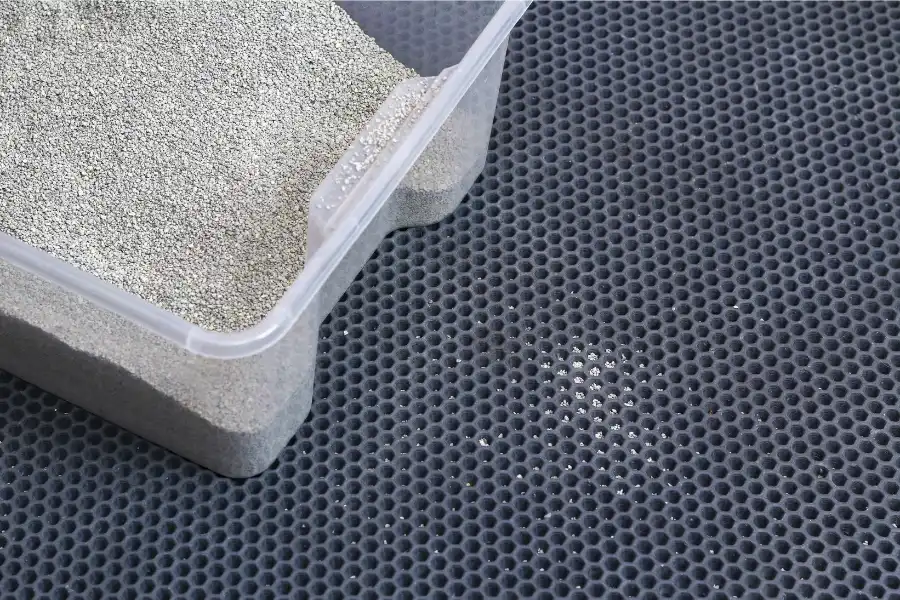
FAQs:
Q. Can you flush cat poop without litter?
A: Yes. Cat poop is generally biodegradable and will not clog the toilet drains
Q: How do I remove dried cat litter stains from concrete?
A: To remove dried cat litter stains from concrete, mix equal parts white vinegar and water and spray on the stain. Let it sit for several minutes, then scrub with a brush and rinse with water. You can also use a commercial stain remover specifically designed for concrete surfaces.
Q: Can I use bleach to clean cat litter stains from concrete?
A: While bleach is an effective cleaner, it is not recommended for cleaning cat litter stains from concrete. Bleach can react with the ammonia in cat urine and create harmful gases. Additionally, bleach can discolor and damage the surface of the concrete.
Q: How often should I clean my cat’s litter box?
A: It is recommended to clean your cat’s litter box at least once a day. This will prevent overflow and reduce the chances of spills and stains. A clean litter box will also help keep your cat healthy and happy.
Q: What can I use to prevent my cat from tracking litter all over the floor?
A: You can use a litter mat or place a rug or towel underneath the litter box to catch any spills. Additionally, you can choose a litter that is less prone to tracking, such as a heavier litter or a litter with larger particles.
Q: Can I use a steam cleaner to clean cat litter stains from concrete?
A: Yes, a steam cleaner can be used to clean cat litter stains from concrete. However, be sure to follow the manufacturer’s instructions carefully and test the steam cleaner on a small, inconspicuous area first to ensure it does not damage the concrete surface.
You might also be interested in:
How To Get Cat Urine Out Of Car Upholstery: Best Hacks
How To Get Rid Of Cat Pee Smell On Wood Floor (& Other Floor Materials)
